New Delhi: Earlier this week, the Supreme Court, taking suo motu cognisance of a Times of India report headlined ‘City hounded by strays, kids pay price’, stated that in view of the “grim situation…immediate steps need be taken to take care of the menace of dog bites leading to rabies”.
A two-judge bench of Justices J.B. Pardiwala and R. Mahadevan said that it was only after “the deepest of deliberations, and having reached the firm conclusion about the systematic failure of the concerned authorities over the past two decades to address an issue that strikes at the heart of public safety, that we have decided to take the matter in our hands”.
The bench then ordered that all stray dogs of Delhi-NCR must be moved to shelters that will be constructed by the municipal authorities. An order that many residents of the capital celebrated as a big shot in the arm for public safety. Meanwhile, animal lovers condemned the move and have been holding protests since, calling it inhumane, unscientific, and unfeasible.
A raging debate has followed. On Wednesday, Chief Justice of India B.R. Gavai referred the matter to a larger, three-judge bench.
At the centre of this burning matter, is the issue of dog bites and the very real threat of a fatal disease—rabies.
Have dog bites and rabies cases risen in the recent past? What prompts a dog to bite a human being? Why has India still not become rabies-free, when other countries have? What can be done to bring down rabies deaths? How does one prevent the spread of rabies, not just in humans, but also among dogs? ThePrint breaks it down.
Also Read: Why activists see SC order on removal of stray dogs as ‘violation’ of 2023 ABC rules
In Delhi, dog bite incidents rising, rabies cases down
Data presented in the Lok Sabha on 1 April this year by the Ministry of Fisheries, Animal Husbandry and Dairying shows that Delhi reported zero rabies deaths between January 2022 and January 2025. Dog bite cases in the capital have dropped sharply, from 25,210 in January 2024 to 3,196 in January 2025.
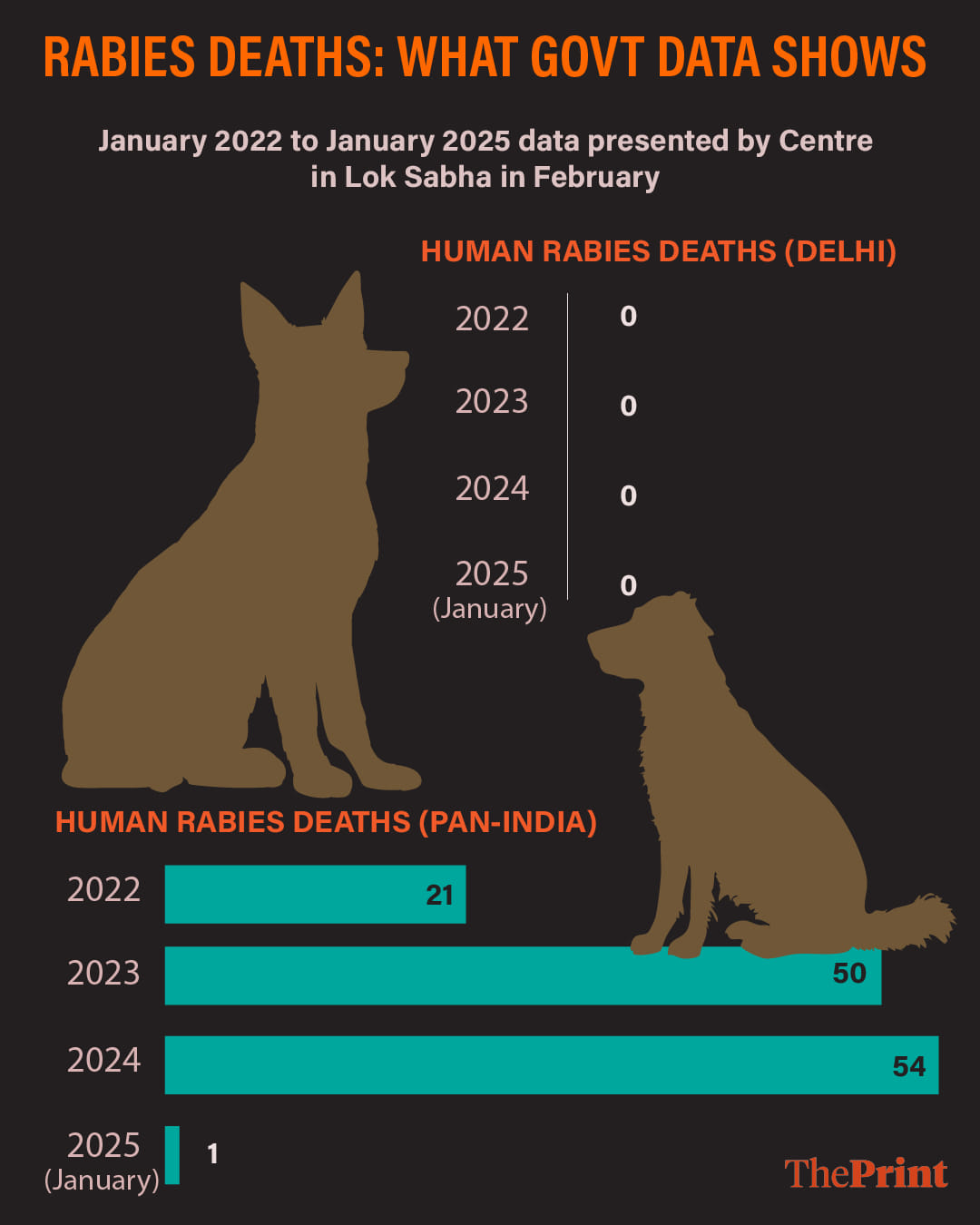
Dog bite cases, however, are rising, according to government data. Nationally, dog bite cases stood at 4,29,664 in January this year. The numbers have risen year-on-year—21,89,909 in 2022, 30,52,521 in 2023, and 37,15,713 in 2024. In Delhi alone, 17,874 dog bite cases were recorded in 2023, followed by 6,691 in 2024.
The data doesn’t specify how many dog bite incidents were attributed to pets and how many to stray dogs.
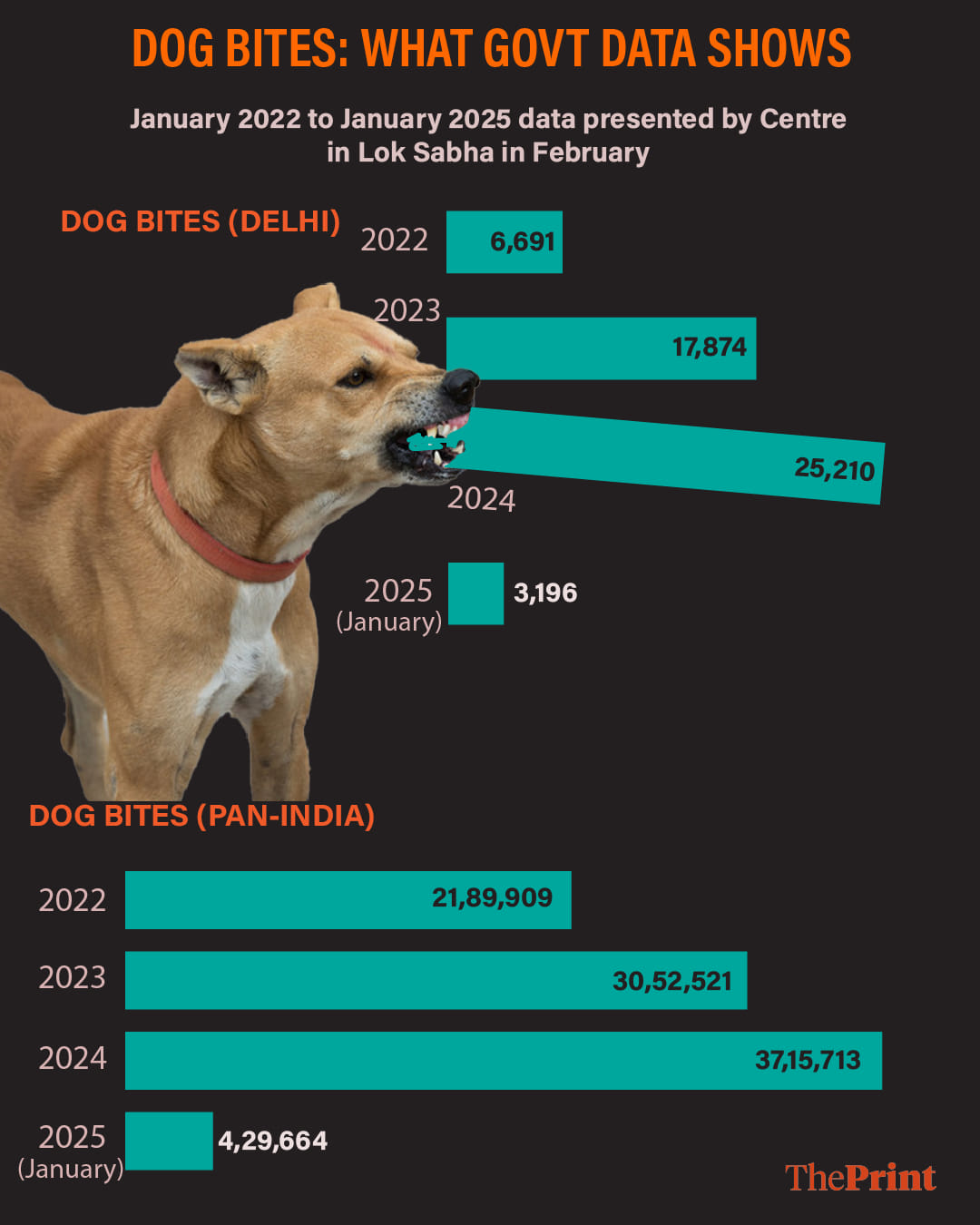
ThePrint also sought dog bites data from Ram Manohar Lohia (RML) Hospital, a government-run facility, which showed that the number of dog bite cases is still high. RML recorded 5,442 cases in January, 4,039 in February, 3,688 in March, and 4,817 in April. The numbers climbed to 4,520 in May, 4,976 in June, and peaked at 7,376 in July, alongside 164 cases of bites from other animals in May.
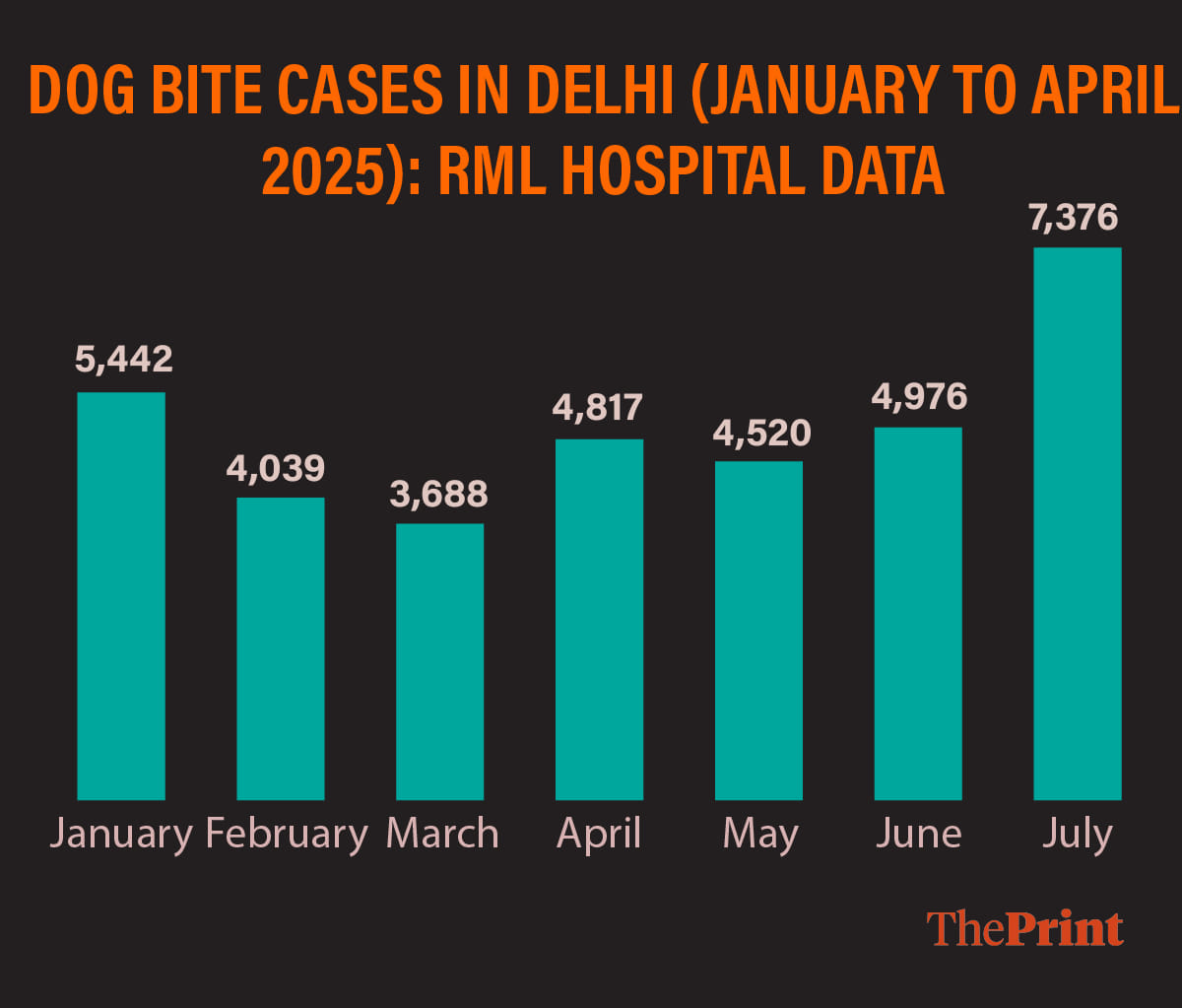
How does rabies spread & how to prevent it
Rabies is a viral disease that affects the brain and nervous system of humans and animals, and is caused by the rabies virus from the Lyssavirus group. It spreads through saliva, usually through bites, scratches, or direct contact with mucosa, and is almost always fatal. There are very few documented cases of survival.
Dogs, followed by bats, are the primary source of human rabies. Cats, monkeys, mongooses, jackals, foxes, wolves can also transmit it. Even today, possibly due to lack of awareness, many people believe that all dogs are rabid, which isn’t the case.
There are two main forms—furious rabies, which causes restlessness, hallucinations, fear of water and air, and aggressive behaviour; and paralytic rabies, which progresses slowly with muscle weakness and paralysis.
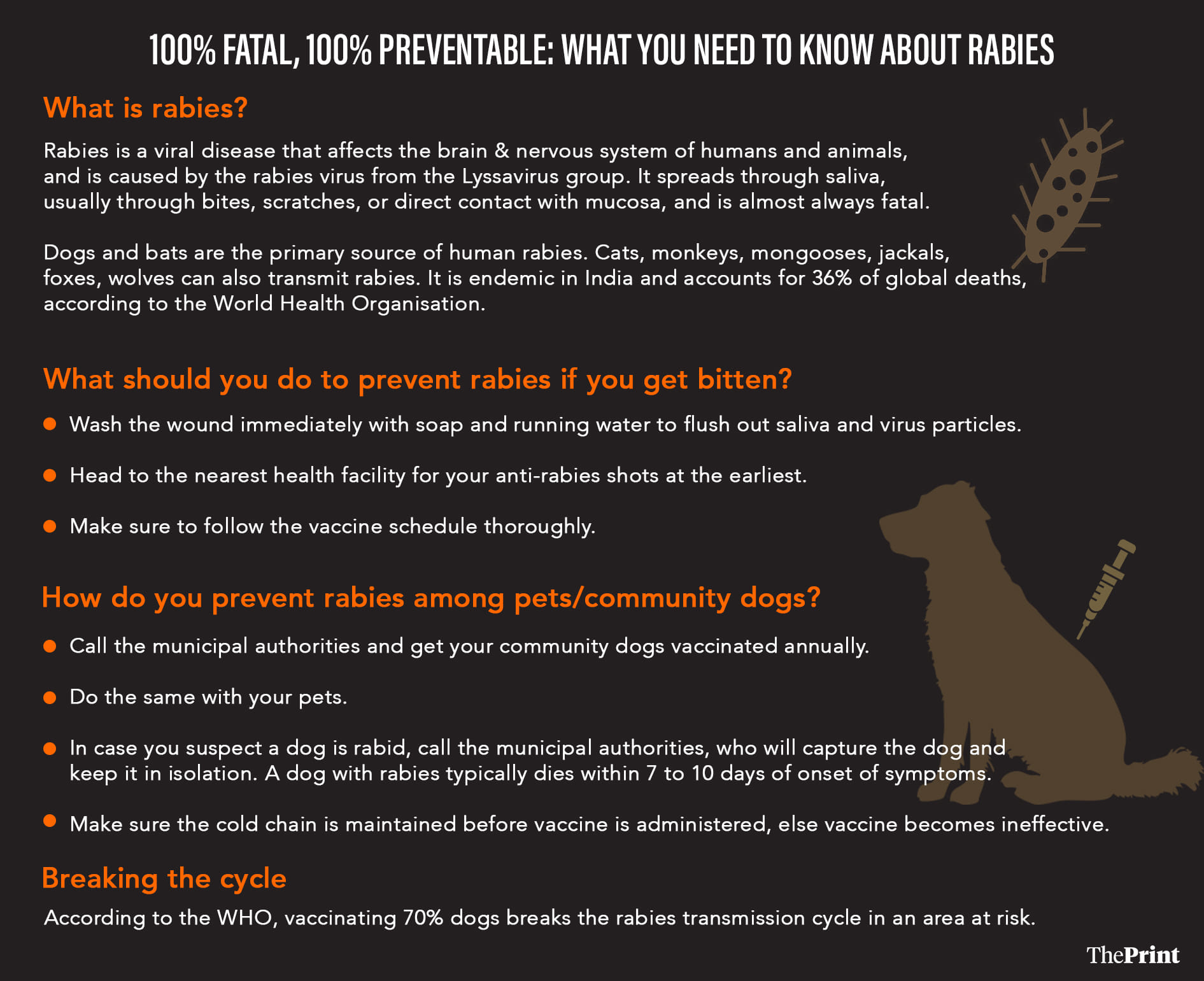
In India, rabies is endemic and accounts for 36 percent of global deaths. The exact national burden is unknown, the World Health Organisation (WHO) says estimates suggest 18,000–20,000 deaths annually, with 30–60 percent of cases involving children under 15, whose bites often go unrecognised or unreported.
In Delhi, rabies vaccination is free of cost at all government hospitals.
The WHO categorises rabies exposure into three levels: Category I (touching or feeding an animal without skin break) which requires no treatment beyond washing; Category II (minor scratches or nibbling without bleeding) which needs wound cleaning and vaccination; and Category III (bites breaking the skin, deep scratches, or saliva contact with mucous membranes) which requires wound cleaning, vaccination, and rabies immunoglobulin (RIG). Once symptoms develop, survival is extremely rare—but the disease is entirely preventable with timely treatment.
Rabies predominantly affects marginalised sections where vaccines, though effective, are inaccessible and unaffordable, according to WHO. It recommends compassionate palliative care once the symptoms emerge and death is inevitable.
‘100% fatal, 100% preventable’
Explaining the treatment protocol, Dr Debashish Parmar, professor at the Department of Internal Medicine, RML Hospital, said vaccines stimulate the body to produce antibodies against rabies, but it takes about 10 days for this protection to develop. “To cover that period, we give immunoglobulin—ready-made antibodies that provide immediate protection until the vaccine takes effect,” he said. Dr Parmar noted that severe Category III bites tend to have a shorter incubation period for symptoms to appear.
He stressed that rabies is “100% fatal but 100% preventable” if both the vaccine and immunoglobulin are administered promptly. “Those who have received both have never developed rabies,” he added.
“Around 90–95 percent of them (the dog bite cases reported to RML) fall into Category III, the severe category,” Dr Parmar said.
He emphasised that the most important first step after a bite is immediate wound washing with soap and running water to flush out saliva and virus particles. “If there is no soap, plain running water should be used,” he said, adding that victims should visit the nearest health facility without delay for vaccination.
‘Vaccination & sterilisation of dogs more effective’
The WHO says vaccinating dogs is the most cost-effective way to prevent rabies in humans. With a global goal of zero dog-mediated human rabies deaths by 2030, WHO has stressed the need for coordinated, standardised processes to track country-level progress.
According to WHO’s expert consultation on rabies, mass dog vaccination has consistently proven effective in controlling the disease, whereas culling does not reduce dog density or curb rabies in the long run.
“Mass culling of dogs should therefore not be a part of a rabies control strategy,” the guidelines note, warning that it can even undermine vaccination efforts, especially for free-roaming dogs. Humane euthanasia is recommended only for animals suspected of having rabies, and only to prevent transmission and relieve suffering. In cases of uncertainty, quarantine and observation are advised.
Why a vaccine cold chain is crucial
Adnaan Khan, founder of the dog training centre K9 School, said vaccination offers a targeted, trackable approach. “Vaccination is a much better option than randomly picking up dogs and throwing them away,” he said, emphasising the need for programmes to create a central database of vaccinated animals, with community members, often those who already care for stray dogs, actively participating.
“That’s the only way we know for sure which dogs are rabies-free, rather than making the radical claim that all strays have rabies,” he added.
Khan also stressed the importance of maintaining records of spayed (females) and neutered (males) dogs, which helps ensure that these animals “have the green rights to exist and not be a problem for society, medically or otherwise”.
Dr Shally Mattoo, who runs SJ’s Pet Care & Clinic in Gurugram, said vaccination alone is not enough, booster doses and sterilisation are equally critical. She noted that municipal programmes often treat a single vaccine dose as sufficient, overlooking the need for annual boosters in endemic countries like India.
“Whenever a disease has to be eradicated, multiple vaccinations are key. Annual rabies vaccination is mandatory here,” she said.
She also highlighted a major challenge—maintaining the cold chain for vaccines. Dr Mattoo alleged that in many cases, government-supplied vaccines fail because they are not stored properly.
The cold chain is a temperature-controlled supply system that keeps vaccines stored and transported within a specific range, usually between 2°C and 8°C, from the manufacturer to the point of use. Maintaining it is essential to preserve the vaccine’s potency and effectiveness.
“Eighty percent of the time, the cold chain is not maintained. I’ve seen vaccines carried by hand without proper refrigeration. In such cases, the vaccine is as good as useless,” she said, adding that her clinic mostly procures vaccines from multinational companies like Pfizer to ensure quality.
Two Animal Birth Control (ABC) centres also told ThePrint that they do not source vaccines from the Municipal Corporation of Delhi (MCD) due to cold chain concerns, instead procuring them from private suppliers.
Internationally, rabies vaccines can remain effective for up to three years, but due to the high viral load in India, annual vaccination is recommended. For dogs that are flown out of the country, authorities require a titer test to confirm immunity before travel.
A titer test measures the level of specific antibodies in the blood to determine if an animal or person has immunity against a disease. In the case of rabies, it helps confirm whether a vaccine has successfully produced adequate protection.
Khan, meanwhile, also warned of the behavioural risks of large-scale dog relocation to shelters. He said cramming thousands of dogs from different territories into one facility can trigger fights, cause injuries, and lead to infections, inbreeding, and even deaths.
“We are not making shelters, we’re making cluster pools of infections and chaos,” he said, adding that with limited funds for handlers, veterinary care, or medicines, injured animals in such shelters could be left untreated for days.
(Edited by Gitanjali Das)
Also Read: Delhi’s war on dogs has turned RWAs into a battleground. ‘They’re fighting, not debating’



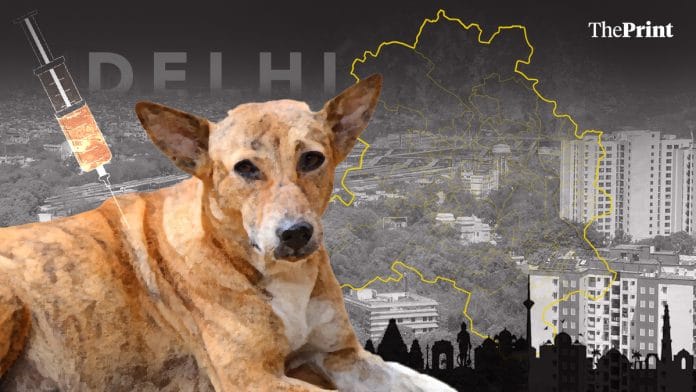



You should also mention that in the US stray dogs, if found, are killed unless someone comes up for adopting them. And in Australia they routinely cull Kangaroos to keep their population under control. Mass euthanasia/or permanent sheltering (perhaps at the expense of the ones who weep) of the strays is essential now as the situation has gone out of control. Typical ABC will not work unless the population is quickly brought to manageable levels. And that can be done only by urgent drastic measures.
The Print has gone overboard in it’s attempt to champion the “cause” of stray dogs.
Such biased, lop-sided journalism facilitated by cherry picking data and WHO recommendations to suit it’s own ideas/narrative is the primary reason why people don’t subscribe despite repeated appeals from Shekhar Gupta.
Shameless attempt to put the blame on the government and municipal authorities while absolving the primary culprits – the stray dogs. It’s equivalent to putting the blame on the government and the police forces for the murder and rape cases happening in a city.